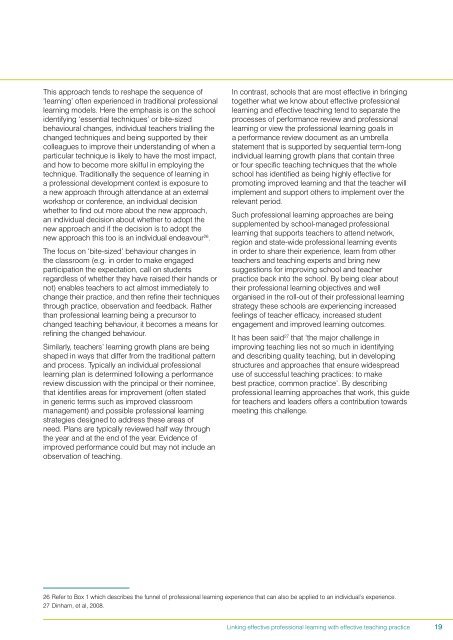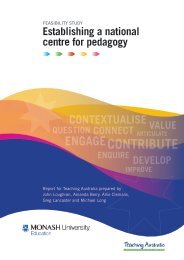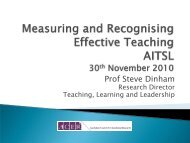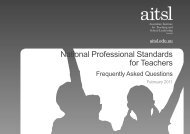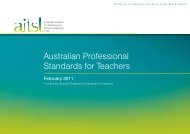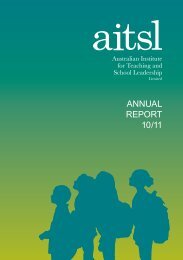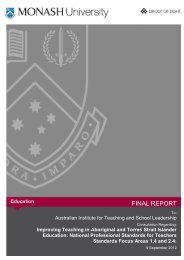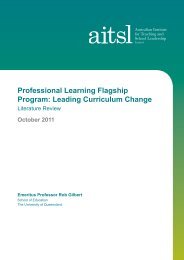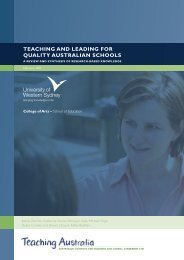Linking effective professional learning with effective teaching practice
Linking effective professional learning with effective teaching practice
Linking effective professional learning with effective teaching practice
Create successful ePaper yourself
Turn your PDF publications into a flip-book with our unique Google optimized e-Paper software.
This approach tends to reshape the sequence of‘<strong>learning</strong>’ often experienced in traditional <strong>professional</strong><strong>learning</strong> models. Here the emphasis is on the schoolidentifying ‘essential techniques’ or bite-sizedbehavioural changes, individual teachers trialling thechanged techniques and being supported by theircolleagues to improve their understanding of when aparticular technique is likely to have the most impact,and how to become more skilful in employing thetechnique. Traditionally the sequence of <strong>learning</strong> ina <strong>professional</strong> development context is exposure toa new approach through attendance at an externalworkshop or conference, an individual decisionwhether to find out more about the new approach,an individual decision about whether to adopt thenew approach and if the decision is to adopt thenew approach this too is an individual endeavour 26 .The focus on ‘bite-sized’ behaviour changes inthe classroom (e.g. in order to make engagedparticipation the expectation, call on studentsregardless of whether they have raised their hands ornot) enables teachers to act almost immediately tochange their <strong>practice</strong>, and then refine their techniquesthrough <strong>practice</strong>, observation and feedback. Ratherthan <strong>professional</strong> <strong>learning</strong> being a precursor tochanged <strong>teaching</strong> behaviour, it becomes a means forrefining the changed behaviour.Similarly, teachers’ <strong>learning</strong> growth plans are beingshaped in ways that differ from the traditional patternand process. Typically an individual <strong>professional</strong><strong>learning</strong> plan is determined following a performancereview discussion <strong>with</strong> the principal or their nominee,that identifies areas for improvement (often statedin generic terms such as improved classroommanagement) and possible <strong>professional</strong> <strong>learning</strong>strategies designed to address these areas ofneed. Plans are typically reviewed half way throughthe year and at the end of the year. Evidence ofimproved performance could but may not include anobservation of <strong>teaching</strong>.In contrast, schools that are most <strong>effective</strong> in bringingtogether what we know about <strong>effective</strong> <strong>professional</strong><strong>learning</strong> and <strong>effective</strong> <strong>teaching</strong> tend to separate theprocesses of performance review and <strong>professional</strong><strong>learning</strong> or view the <strong>professional</strong> <strong>learning</strong> goals ina performance review document as an umbrellastatement that is supported by sequential term-longindividual <strong>learning</strong> growth plans that contain threeor four specific <strong>teaching</strong> techniques that the wholeschool has identified as being highly <strong>effective</strong> forpromoting improved <strong>learning</strong> and that the teacher willimplement and support others to implement over therelevant period.Such <strong>professional</strong> <strong>learning</strong> approaches are beingsupplemented by school-managed <strong>professional</strong><strong>learning</strong> that supports teachers to attend network,region and state-wide <strong>professional</strong> <strong>learning</strong> eventsin order to share their experience, learn from otherteachers and <strong>teaching</strong> experts and bring newsuggestions for improving school and teacher<strong>practice</strong> back into the school. By being clear abouttheir <strong>professional</strong> <strong>learning</strong> objectives and wellorganised in the roll-out of their <strong>professional</strong> <strong>learning</strong>strategy these schools are experiencing increasedfeelings of teacher efficacy, increased studentengagement and improved <strong>learning</strong> outcomes.It has been said 27 that ‘the major challenge inimproving <strong>teaching</strong> lies not so much in identifyingand describing quality <strong>teaching</strong>, but in developingstructures and approaches that ensure widespreaduse of successful <strong>teaching</strong> <strong>practice</strong>s: to makebest <strong>practice</strong>, common <strong>practice</strong>’. By describing<strong>professional</strong> <strong>learning</strong> approaches that work, this guidefor teachers and leaders offers a contribution towardsmeeting this challenge.26 Refer to Box 1 which describes the funnel of <strong>professional</strong> <strong>learning</strong> experience that can also be applied to an individual’s experience.27 Dinham, et al, 2008.<strong>Linking</strong> <strong>effective</strong> <strong>professional</strong> <strong>learning</strong> <strong>with</strong> <strong>effective</strong> <strong>teaching</strong> <strong>practice</strong>19


